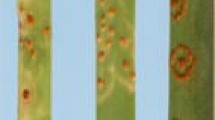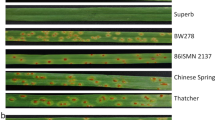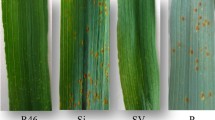Abstract
Key message
A novel and highly effective source of anthracnose resistance in narrow-leafed lupin was identified. Resistance was shown to be governed by a single dominant locus. Molecular markers have been developed, which can be used for selecting resistant genotypes in lupin breeding.
Abstract
A screening for anthracnose resistance of a set of plant genetic resources of narrow-leafed lupin (Lupinus angustifolius L.) identified the breeding line Bo7212 as being highly resistant to anthracnose (Colletotrichum lupini). Segregation analysis indicated that the resistance of Bo7212 is inherited by a single dominant locus. The corresponding resistance gene was given the designation LanrBo. Previously published molecular anchor markers allowed us to locate LanrBo on linkage group NLL-11 of narrow-leafed lupin. Using information from RNAseq data obtained with inoculated resistant vs. susceptible lupin entries as well as EST-sequence information from the model genome Lotus japonicus, additional SNP and EST markers linked to LanrBo were derived. A bracket of two LanrBo-flanking markers allows for precise marker-assisted selection of the novel resistance gene in narrow-leafed lupin breeding programs.




Similar content being viewed by others

References
Boeckmann B, Bairoch A, Apweiler R, Blatter M-C, Estreicher A, Gasteiger E, Martin MJ, Michoud K, O’Donovan C, Phan I (2003) The SWISS-PROT protein knowledgebase and its supplement TrEMBL in 2003. Nucleic Acids Res 31:365–370
Boersma JG, Pallotta M, Li C, Buirchell BJ, Sivasithamparam K, Yang H (2005) Construction of a genetic linkage map using MFLP and identification of molecular markers linked to domestication genes in narrow-leafed lupin (Lupinus angustifolius L.). Cell Mol Biol Lett 10:331–344
Budowle B, Chakraborty R, Giusti AM, Eisenberg AJ, Allen RC (1991) Analysis of the VNTR locus D1S80 by the PCR followed by high-resolution PAGE. Am J Hum Genet 48:137
Cowling WA, Gladstones JS (2000) Lupin Breeding in Australia. In: Knight R (ed) Linking Research and Marketing Opportunities for Pulses in the 21st Century. Springer, Netherlands, pp 541–547
DESTATIS (2014) Land- und Forstwirtschaft, Fischerei. Landwirtschaftliche Bodennutzung—Anbau auf dem Ackerland 2014 (Vorbericht). Statistisches Bundesamt
FAOSTAT (2014) FAOSTAT. FAO, Rome, Italy
Gao L, Hane J, Kamphuis L, Foley R, Shi B, Atkins C, Singh K (2011) Development of genomic resources for the narrow-leafed lupin (Lupinus angustifolius): construction of a bacterial artificial chromosome (BAC) library and BAC-end sequencing. BMC Genom 12:521
Gondran J, Bournoville R, Duthion C (1994) Identification of diseases, pests and physical constraints in white lupin. INRA
Goya R, Sun MG, Morin RD, Leung G, Ha G, Wiegand KC, Senz J, Crisan A, Marra MA, Hirst M, Huntsman D, Murphy KP, Aparicio S, Shah SP (2010) SNVMix: Predicting single nucleotide variants from next-generation sequencing of tumors. Bioinformatics 26:730–736
Grabherr MG, Haas BJ, Yassour M, Levin JZ, Thompson DA, Amit I, Adiconis X, Fan L, Raychowdhury R, Zeng Q, Chen Z, Mauceli E, Hacohen N, Gnirke A, Rhind N, di Palma F, Birren BW, Nusbaum C, Lindblad-Toh K, Friedman N, Regev A (2011) Full-length transcriptome assembly from RNA-Seq data without a reference genome. Nat Biotech 29:644–652
Hayden MJ, Nguyen TM, Waterman A, McMichael GL, Chalmers KJ (2008) Application of multiplex-ready PCR for fluorescence-based SSR genotyping in barley and wheat. Mol Breed 21:271–281
Kamphuis LG, Hane JK, Nelson MN, Gao L, Atkins CA, Singh KB (2014) Transcriptome sequencing of different narrow-leafed lupin tissue types provides a comprehensive uni-gene assembly and extensive gene-based molecular markers. Plant Biotechnol J 13:14–25
Kroc M, Koczyk G, Święcicki W, Kilian A, Nelson M (2014) New evidence of ancestral polyploidy in the Genistoid legume Lupinus angustifolius L. (narrow-leafed lupin). Theor Appl Genet 127:1237–1249
Lambers H, Clements JC, Nelson MN (2013) How a phosphorus-acquisition strategy based on carboxylate exudation powers the success and agronomic potential of lupines (Lupinus, Fabaceae). Am J Bot 100:263–288
Lassmann T, Hayashizaki Y, Daub CO (2009) TagDust-a program to eliminate artifacts from next generation sequencing data. Bioinformatics 25:2839–2840
Michelmore RW, Meyers BC (1998) Clusters of resistance genes in plants evolve by divergent selection and a birth-and-death process. Genome Res 8:1113–1130
Nelson MN, Moolhuijzen PM, Boersma JG, Chudy M, Lesniewska K, Bellgard M, Oliver RP, Święcicki W, Wolko B, Cowling WA, Ellwood SR (2010) Aligning a New Reference Genetic Map of Lupinus angustifolius with the Genome Sequence of the Model Legume, Lotus japonicus. DNA Res 17:73–83
Nirenberg HI, Feiler U, Hagedorn G (2002) Description of Colletotrichum lupini comb. nov. in modern terms. Mycologia 94:307–320
Paulitz T (1995) First report of Colletotrichum gloeosporioides on lupine in Canada. Plant Dis 79
Reed P, Dickens J, O’Neill T (1996) Occurrence of anthracnose (Colletotrichum acutatum) on ornamental lupin in the United Kingdom. Plant Pathol 45:245–248
Ruge-Wehling B, Dieterich R, Thiele C, Eickmeyer F, Wehling P (2009) Resistance to anthracnose in narrow-leafed lupin (Lupinus angustifolius L.): sources of resistance and development of molecular markers. J für Kulturpflanzen 61:62–65
Stein N, Herren G, Keller B (2001) A new DNA extraction method for high-throughput marker analysis in a large-genome species such as Triticum aestivum. Plant Breeding 120:354–356
Sweetingham MW, Cowling WA, Buirchell BJ, Brown AGP, Shivas RG (1995) Anthracnose of lupins in Western Australia. Australas Plant Pathol 24:271
Temnykh S, DeClerck G, Lukashova A, Lipovich L, Cartinhour S, McCouch S (2001) Computational and experimental analysis of microsatellites in rice (Oryza sativa L.): frequency, length variation, transposon associations, and genetic marker potential. Genome Res 11:1441–1452
Untergasser A, Cutcutache I, Koressaar T, Ye J, Faircloth BC, Remm M, Rozen SG (2012) Primer3—new capabilities and interfaces. Nucleic Acids Res 40:e115
Utz H (2001) Plabstat. Saatgutforschung und Populationsgenetik der Universität Hohenheim, Ein Computerprogramm zur statistischen Analyse von pflanzenzüchterischen Experimenten Institut für Pflanzenzüchtung
v. Sengbusch R (1930) Bitterstoffarme Lupinen. Theoret Appl Genet 2:1–11
Van Ooijen JW (2011) Multipoint maximum likelihood mapping in a full-sib family of an outbreeding species. Genetic Res 93:6
Voorrips RE (2002) MapChart: software for the graphical presentation of linkage maps and QTLs. J Hered 93:77–78
Vos P, Hogers R, Bleeker M, Reijans M, van de Lee T, Hornes M, Frijters A, Pot J, Peleman J, Kuiper M et al (1995) AFLP: a new technique for DNA fingerprinting. Nucleic Acids Res 23:4407–4414
Weber WE, Wricke G (1994) Genetic markers in plant breeding. Advances in Plant Breeding. Beiheft zur Zeitschr Pflanzenzüchtg 16:57–58
Wolko B, Clements J, Naganowska B, Nelson M, Ha Yang (2011) Lupinus. In: Kole C (ed) Wild Crop Relatives: Genomic and Breeding Resources. Springer, Berlin Heidelberg, pp 153–206
Yang H, Boersma J, You M, Buirchell B, Sweetingham M (2004) Development and implementation of a sequence-specific PCR marker linked to a gene conferring resistance to anthracnose disease in narrow-leafed lupin (Lupinus angustifolius L.). Mol Breed 14:145–151
Yang H, Renshaw D, Thomas G, Buirchell B, Sweetingham M (2008) A strategy to develop molecular markers applicable to a wide range of crosses for marker assisted selection in plant breeding: a case study on anthracnose disease resistance in lupin (Lupinus angustifolius L.). Mol Breed 21:473–483
Yang H, Tao Y, Zheng Z, Li C, Sweetingham M, Howieson J (2012) Application of next-generation sequencing for rapid marker development in molecular plant breeding: a case study on anthracnose disease resistance in Lupinus angustifolius L. BMC Genom 13:318
Yang H, Tao Y, Zheng Z, Zhang Q, Zhou G, Sweetingham MW, Howieson JG, Li C (2013) Draft genome sequence, and a sequence-defined genetic linkage map of the legume crop species Lupinus angustifolius L. PLoS One 8:e64799
You M, Boersma JG, Buirchell BJ, Sweetingham MW, Siddique KH, Yang H (2005) A PCR-based molecular marker applicable for marker-assisted selection for anthracnose disease resistance in lupin breeding. Cell Mol Biol Lett 10:123–134
Acknowledgments
This work was funded by the German Federal Ministry of Food and Agriculture (BMEL) within the program to promote innovation (FKZ 28-1-41.028-06) and supported by grants from the Grains Research and Development Corporation (GRDC) to KBS (UWA00147) and MN (UWA00151).
Author information
Authors and Affiliations
Corresponding author
Ethics declarations
Conflict of interest
The authors declare that they have no conflict of interest.
Ethical standards
This article does not contain any studies with human participants or animal performed by any of the authors.
Additional information
Communicated by D. A. Lightfoot.
Electronic supplementary material
Below is the link to the electronic supplementary material.
Rights and permissions
About this article
Cite this article
Fischer, K., Dieterich, R., Nelson, M.N. et al. Characterization and mapping of LanrBo: a locus conferring anthracnose resistance in narrow-leafed lupin (Lupinus angustifolius L.). Theor Appl Genet 128, 2121–2130 (2015). https://doi.org/10.1007/s00122-015-2572-3
Received:
Accepted:
Published:
Issue Date:
DOI: https://doi.org/10.1007/s00122-015-2572-3



